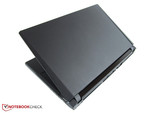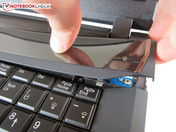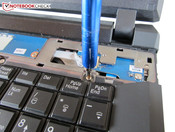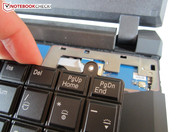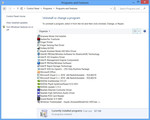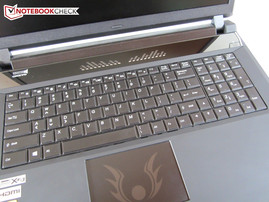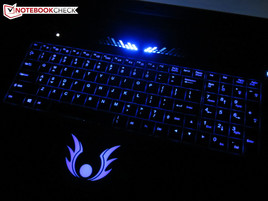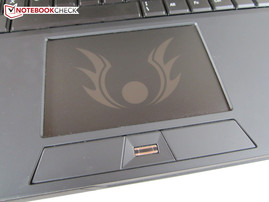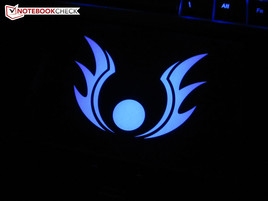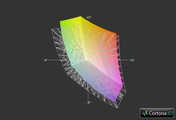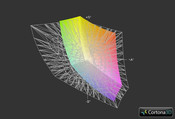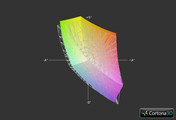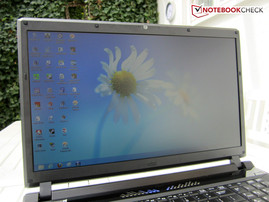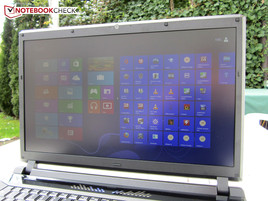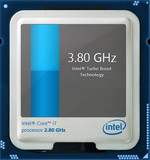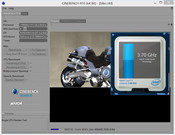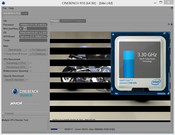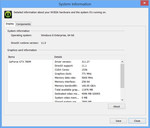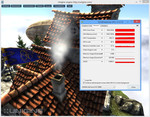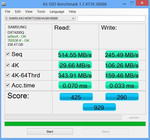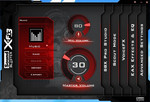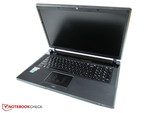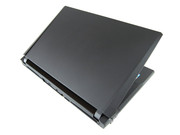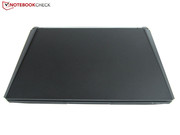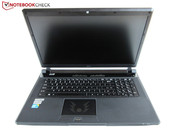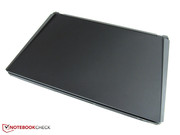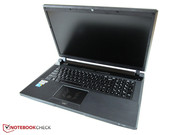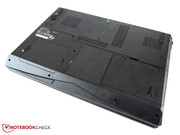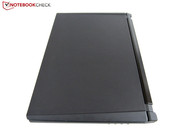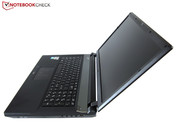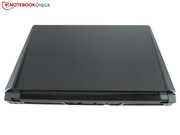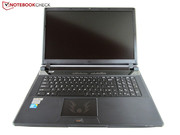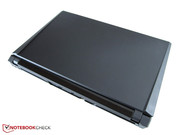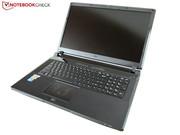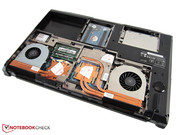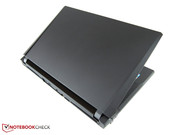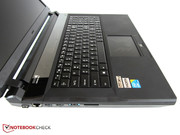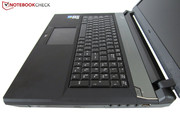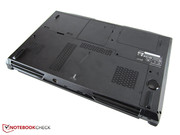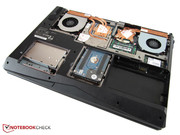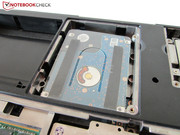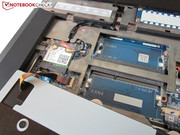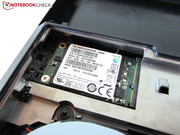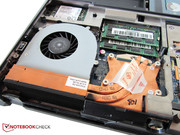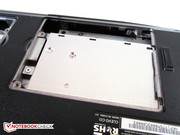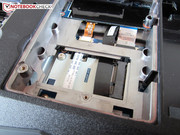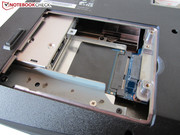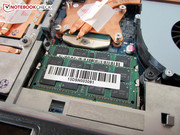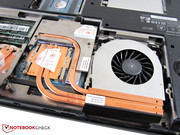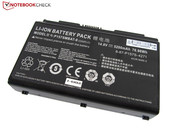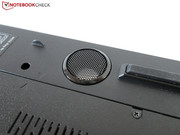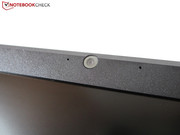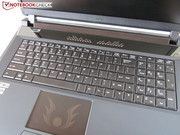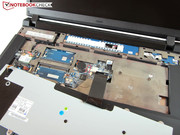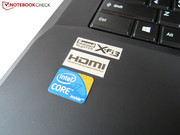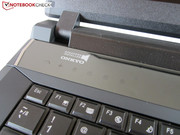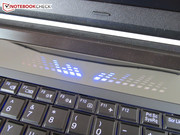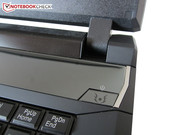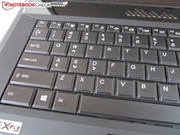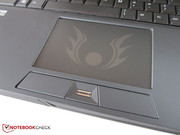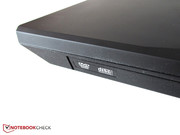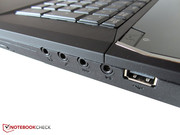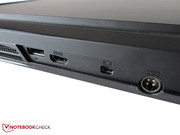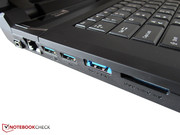Review Schenker XMG P703 (Clevo P177SM) Notebook
For the original German review, see here.
Schenker's laptops can be found among the entire middle and top tiers of gaming devices, ranging from smaller 11-inch devices such as the XMG A102 (GeForce GT 650M) to potent 15-inch laptops like the XMG A522 (GeForce GTX 660M) and expensive 17-inch notebooks such as the XMG U702 (dual GPU). Among the best and most successful laptops of the German company are the XMG P502 (86%) and the XMG P702 (87%) each of which can be fitted with several different graphics cards.
But now the era of a new generation is dawning, led by the XMG P503 and the XMG P703. Like their older siblings, both desktop replacement devices are configurable in many different regards - they can even be fitted according to individual needs (mysn.de), allowing the user to choose their favorite processor, several graphics cards, up to 32 GB DDR3-RAM, either a DVD or Blu-ray optical drive, different Wi-Fi modules and also the operating system (although Windows 7 is not officially supported yet).
One of the greatest highlights about the P703 is the ability to fit up to four hard drives into the device, in two 2.5-inch drive bays and on two compact mSATA slots. The Schenker laptop ships with a matte Full HD panel with 1920x1080 pixels. Its base price can quickly climb up to several thousand Euros depending on the hardware used.
Note: Our luxuriant test device is from a pre-production batch which has not yet been finalized (BIOS, drivers, etc ...). Some details such as the fan control system do not necessarily have to remain unchanged in the customer version. The CPU was also still in an "engineering state".
The case has not been manufactured by Schenker, but by the Taiwanese gaming expert Clevo. With its rubberized surfaces, the P177SM barebone of the Schenker XMG P703 reminds us more of its dual CPU colleague P370EM (Schenker XMG P722) than the already mentioned single GPU sibling P170EM (Schenker XMG P702).
Both the lid and the palm rest sport a soft-touch finish. Still, these rubberized surfaces remain a matter of taste. While offering more of a premium look than plastic and quite a pleasant feel, the laptop is extremely prone to fingerprints, especially so with greasy fingers. Eating greasy food while playing almost becomes a no-go. At least stains can be easily removed with a wet cotton or microfiber cloth.
The build quality of our test device was also far from perfect. While the base unit was generally well-constructed, the display frame (finally without any gloss!) felt very uneven and wobbly. We were easily able to pull the frame out or press it in by a few millimeters which led to actual distortions on the display. Depending on the viewing angle, even the display lighting units could be made out at a few sections of the frame - a flaw which might be due to its pre-production status.
Apart from the lid, the rest of the case is rather torsion-resistant and sturdy. Only the keyboard and the area surrounding the fingerprint reader give way when a lot of pressure is applied. Considering the size (414 x 286 x 54 millimeters) and the high weight (almost four kilograms), the notebook can be called colossal. The 17-inch is basically unsuited for frequent traveling. The brand-new and even chunkier P170SM barebone, successor to the P170EM, is similarly massive.
The design is once again subject to a personal matter of taste. We personally disliked both the tribal emblem on the touchpad - which will be replaced by a logo of Schenker's choice in the customer version - and the glossy bar right above the keyboard. Even worse: As it appears, the volume display cannot be deactivated. This is a shame, as we found the frenzied flashing to be so annoying that we have simply duct-taped this "disco ball". We suppose that many users will feel the same way about this "feature".
Still, overall build quality was more than decent. Of course, one shouldn't expect such a quality as that which is found with Alienware or Asus (it might be interesting to compare the P703 to the M17x R4 or the G75VX). By the way: The final customer version will sport an XMG logo on its lid.
Ports
The ports have barely changed from the P702. While the right hand side offers four audio jacks (7.1 Surround Sound!) and a USB 2.0 port, the left hand side sports not only a 9-in-1 card reader and an RJ-45 Gigabit Ethernet port, but also two USB 3.0 ports, a Mini FireWire port and an eSATA/USB 3.0 combo port. The back of the laptop is crowded with a Kensington lock, an HDMI port, the power connector and two DisplayPorts (1x Standard, 1x Mini). The XMG P702 had a DVI port instead of the Mini DisplayPort.
Next to the large variety of ports we also have to mention their elaborate layout. Since all ports are located close to the back of the laptop, there is more than enough space for using an external mouse.
Wireless Communication
The standard configuration makes use of an Intel Centrino Wireless-N 2230 combo adapter which supports both Bluetooth 4.0 and Wi-Fi 802.11 b/g/n with a data transfer rate of up to 300 Mbit/s (2.4 GHz), Wireless Display and Smart Connect included. During our tests, the radio range proved to be decent. Still, other WiFi modules are offered for a premium.
Maintenance
Almost no other gaming laptop manages to rival the Schenker XMG P703 in terms of maintenance options. The bottom panel alone sports three maintenance hatches. Number one reveals the primary 2.5-inch drive bay and one mSATA slot. Beneath hatch number two, the optical drive and (below that) a secondary 2.5-inch drive bay are hidden.
The majority of options are offered under the third (and largest) hatch. The graphics card, the processor, the primary memory banks and another mSATA slot can be accessed here. Nice: CPU and GPU sport two different cooling systems. Thanks to the user-friendly setup, the innards are very easy to clean and replace.
Replacing the keyboard can be somewhat trickier than what can be seen in our gallery. This is necessary in order to access the Wi-Fi module and the third and fourth memory banks. After pulling off the glossy bar right above the keyboard, the keyboard itself can be unscrewed. But although this might be more difficult than just opening a maintenance hatch, we don't think it should be too hard to do this without damaging the laptop. Actually, most upgrades can be done by laypeople as well.
Software
One of the biggest advantages of barebone makers is the clean Windows install they offer. No annoying bloatware or unnecessary manufacturer software is included, thus leaving us with a responsive system without constant popup messages. As shown by the screenshot on the right, Schenker concentrates on hardware drivers.
Delivery contents
Our test device only came with a driver DVD while the customer version will probably ship with a manual as well. Those who order an OS version do actually get an original Windows DVD. Some words concerning the 230 watts power adapter: It weighs 0.9 kilograms while measuring 178 x 88 x 35 millimeters. The 8-cell battery offers a capacity of 77 Wh, coming in at 420 grams.
Warranty
The P703 ships with a standard warranty time of 24 months, which can be increased to three or four years for another 100 or 200 Euros (~$130 or $260) respectively. Schenker claims this to be a pickup & return service, including several months of "instant-repairs". Outside of Germany, only a bring-in service is offered.
Keyboard
Our favorite feature concerning the keyboard is its homogeneous, incremental backlighting. Each of the three "zones" of the keyboard can be illuminated by one of eight colors, e.g. red, yellow, cyan, green or the default, a dark blue. There are several operation modes to choose from, among them crazy ones like "Dancing", "Flash" or "Wave".
But even apart from this key feature, the keyboard fares rather well. Pressure point, keystrokes and feedback felt (and sounded) fine. The keys are also sufficiently large, although they lose 4 of their 17 millimeters due to their graded rims. Both the four-column numpad and the practical special keys are plus points. The F-row contains, among other things, brightness and volume controls as well as (de)activation keys for the display, the touchpad, the webcam (with 2.0 megapixels) and the radio module.
What we cannot understand is why Clevo chose to exchange the Fn and Windows keys. Clevo's usage of a single-rowed return key has been tradition since their first backlit keyboards. We are not impressed by the overall layout - no matter whether we are talking about the German or US layout. As with MSI, the ><| is strangely positioned (as can be seen on the GT70). At least the arrow keys are standard-sized. Still, prolific writers might want to choose a different laptop.
Touchpad
Clevo is known for having problems with designing decent touchpads. There are a wide variety of different issues, ranging from the "sandpaper" touchpad on the W150ER (the Schenker XMG A502) to the rubberized and rather "sticky" touchpad on the P150HM (the Schenker XMG P502). Despite the fact that the touchpad of the P177SM manages to forgo any material experiments, sticking to plastic, some issues remain.
The clearances are an invitation for dust and dirt. We also didn't like that Clevo chose to lower the touchpad into the case when compared to the surrounding palm rest. Thus, the fingers have to be lifted considerably in order to reach the dedicated (and somewhat ramshackle) touchpad buttons. The enormous difference in height can get quite annoying during daily usage.
Precision and reliability of the supported zoom, scroll, pinch and rotation gestures leave something to be desired. At least the "Sentelic Finger Sensing Pad", as the touchpad is called, is amply sized, measuring 10.5 x 7 centimeters.
As mentioned before, Schenker ships the P703 with a non-glare panel. 1920x1080 pixels offer more than enough desktop real estate for extensive multitasking while being the perfect resolution for Full HD video material. High-performance graphics cards such as the GeForce GTX 780M chime in well with this resolution (something for which many mid-range cards lack the necessary performance).
| |||||||||||||||||||||||||
Brightness Distribution: 72 %
Center on Battery: 309 cd/m²
Contrast: 909:1 (Black: 0.34 cd/m²)
61.8% AdobeRGB 1998 (Argyll 3D)
85.1% sRGB (Argyll 3D)
60.7% Display P3 (Argyll 3D)
The integrated Chi Mei N173HGE-L11 panel might be known to some of our readers. It has been used on dozens of gaming platforms in the past, e.g. by Asus (the G75VW) or MSI (the GT70). A quick glance at the measurements shows the reason for this, as the display offers above-average image quality, at least for a TN panel.
Overall, we were rather fond of the display, with the exceptions of the mediocre brightness homogeneity (~72%) and some color rendition inaccuracies. Thanks to its great luminosity (~300 cd/m²) and rather low black levels (~ 0.34 cd/m²), a more than decent contrast ratio of around 900:1 is achieved. As inferior TN panels are often used in the price range below 1000 Euros (~$1304) they tend not to even reach a ratio of 500:1. Despite this being a matte display, colors were luscious and crisp.
Despite of the presence of a subtle yellow tint which is only visible when viewed from a narrow angle, the display offers decent viewing angle stability. As with all TN panels, vertical variations of the relative position should be minimized as tilting the display results in visible changes in the illumination pattern. Still, the XMG P703 remains a viable entertainment system for several users at the same time. One small issue: The rather "grainy" finish of the Chi Mei N173HGE-L11 might be deemed bothersome by some of its more sensitive users.
Processor
2013 is the year of Intel's promising Haswell CPU architecture. While still being manufactured using the 22 nm process, the successor to the Ivy Bridge platform is supposed to offer superior performance thanks to numerous optimizations.
The HM87 motherboard of our test device is fitted with a Core i7-4900MQ, one of the most powerful new CPUs. It comes with 8 MB of L3 cache and a CPU clock speed of 2.8-3.8 GHz, similar to the old Core i7-3840QM despite an increased thermal design power (TDP) of 47 watts instead of 45 watts. For comparison: The 2.7-3.7 GHz model, the Core i7-4800MQ, comes with just 6 MB of L3 cache.
As usual, Hyper Threading allows the quad-core to be accompanied by four virtual cores, enabling eight parallel threads. In order to save electricity while idle or being used on simple tasks like office usage or web browsing, the P177SM is capable of seamlessly and automatically switching between the dedicated GPU and the integrated HD Graphics 4600 - a technology called Nvidia Optimus (the counterpart to AMD's Enduro).
We will further discuss whether Haswell manages to completely outperform the still-potent Ivy Bridge generation below.
Turbo Boost
As implied above, the Core i7-4900MQ is capable of increasing its clock speed from 2.8 to up to 3.8 GHz under full load. Usually, the CPU only comes close to the theoretical maximum of 3.8 GHz when just one core is taxed.
According to Intel's Turbo Boost Monitor, the Haswell CPU remained between 3.7 and 3.8 GHz during the Single Core Rendering test of Cinebench R10. We were somewhat disappointed by the Multi Core Rendering result: 3.3 GHz isn't bad, but the theoretical potential of the Core i7-4900MQ lies higher. Temperature development and power consumption of the other components might be the limiting factors here. Apparently, the GeForce GTX 780M stretches the P177SM barebone to its limits.
Then again, the potential customer base capable of exploiting the Core i7-4900MQ to its fullest might be very small. Even hardcore gamers will be just as happy with some of the cheaper quad-core variants. Great: There were no throttling issues at all.
CPU Performance
Since the XMG P703's Turbo mode rarely comes close to its potential peak performance, the Core i7-4900MQ barely manages to beat the older generation: While it takes the lead by 10% during the Single CPU test of Cinebench R11.5 (1.70 points instead of 1.59 when compared to the Core i7-3840QM), it is perfectly on par with its older competitor during the Multi CPU test (7.1 points instead of 7.15 points). The extremely popular entry-level quad-core processor Core i7-3630QM, which is used in the Asus N56VB-S4050H, the MSI GT60 0NG-294US and the Lenovo IdeaPad Y500, falls behind by just 10-20% (yielding 1.4 and 6.4 points respectively).
We want to stress, however, that all these results have been measured on an engineering sample. It is possible that the final customer version might be faster.
| Cinebench R10 | |
| Rendering Single CPUs 64Bit (sort by value) | |
| Core i7-4900MQ | |
| Core i7-3630QM | |
| Core i7-3840QM | |
| Rendering Multiple CPUs 64Bit (sort by value) | |
| Core i7-4900MQ | |
| Core i7-3630QM | |
| Core i7-3840QM | |
Graphics Card
Nvidia's GeForce GTX 780M is its strongest laptop GPU for gamers. According to its technical specifications, it is basically a faster variant of the GeForce GTX 680MX (Kepler architecture as well) which so far has been used exclusively in Apple's iMac. The memory interface (256-bit), the memory clock speed (2500 MHz) and the shader pipelines (1536 computational units) are identical.
4096 MB GDDR5-VRAM should be more than enough, even for the foreseeable future. While the clock speed of the GeForce GTX 680M (respectively GTX 680MX) comes down to 720 MHz, the GeForce GTX 780M manages 823 MHz, 14% more.
According to the tool GPU-Z the graphic-turbo (GPU Boost) hits 849 MHz. The older high-end models lacked such an automatic overclocking option. The DirectX 11 GPU manufactured in a 28 nm process offers PhysX, CUDA and - with the right hardware - 3D Vision.
We were actually surprised by the preinstalled GPU driver: The ForceWare 311.27 was already several months old when we conducted this test. No official Nvidia driver support for the GeForce GTX 780M existed at the time of writing.
GPU Performance
Despite the fact that the GeForce GTX 780M does not bring along a fresh GPU architecture, the difference to all preceding high-end graphics cards is more than respectable. According to the Unigine Heaven 3.0 benchmark (1920x1080, high, tessellation normal), the GTX 780M operates around 30% faster than the Radeon HD 7970M (59.1 fps @ Schenker XMG P502) and the GeForce GTX 680M (57.7 @ Schenker XMG P502). With an average of 76.0 fps, the little brother GeForce GTX 765M is left behind by a factor of two (36.0 fps @ Schenker W503).
The results of the Fire Strike test within 3DMark 2013 were another success for the GTX 780M. Its 5234 points are far better than both the Radeon HD 7970M (4694 points, -10%) and the GeForce GTX 680M (3952 points, -25%), even more so when compared to the GeForce GTX 765M (2479 points).
| 3DMark 11 - 1280x720 Performance GPU (sort by value) | |
| GeForce GTX 780M | |
| GeForce GTX 765M | |
| GeForce GTX 770M | |
| GeForce GTX 680M | |
| Radeon HD 7970M | |
| Unigine Heaven 2.1 - 1280x1024 high, Tesselation (normal), DirectX11 AA:off AF:1x (sort by value) | |
| GeForce GTX 780M | |
| GeForce GTX 765M | |
| GeForce GTX 770M | |
| GeForce GTX 680M | |
| Radeon HD 7970M | |
| 3DMark 06 Standard Score | 24351 points | |
| 3DMark Vantage P Result | 26827 points | |
| 3DMark 11 Performance | 7793 points | |
| 3DMark Ice Storm Standard Score | 88117 points | |
| 3DMark Cloud Gate Standard Score | 18258 points | |
| 3DMark Fire Strike Score | 4742 points | |
Help | ||
Storage solution
Schenker did not only equip our test device with two 1 TB HDDs, but also with a 256 GB mSATA SSD, a Samsung SSD PM841 (MZMTD256HAGM), which doesn't have to shy away from competing with "actual" solid state drives.
With a sequential reading speed of 515 MB/s and a sequential writing speed of 245 MB/s, the PM841 comes close to its 2.5-inch sibling, the Samsung SSD 840 in the AS SSD benchmark. Still, the 500 MB/s writing speed of the top variant, the Samsung SSD 840 Pro, is a far cry away. The PM841's access times of 0.07 m/s and 0.03 m/s (reading / writing) are superb.
Both 1 TB HDDs are also way above average. Hitachi's Travelstar 7K1000 (HTS721010A9E630) is one of the best HDDs which can be bought right now, achieving sequential reading and writing speeds of around 130 MB/s as measured with CrystalDiskMark. Seagate's hybrid hard drive, the Momentus XT 7200.1 (ST750LX003) which also spins at 7200 revolutions per minute, offers comparable real-life performance.
Exemplary: On its website, Schenker offers a large variety of HDDs, SSDs and SSHs of numerous manufacturers (Crucial, Intel, Plextor, etc ...).
System Performance
The system benchmarks reveal that the Schenker XMG P703 easily bests the majority of its competition. 21350 points in PCMark Vantage is barely less than the results of two super-fast dual GPU laptops by Schenker (the XMG P722 with a GeForce GTX 680M SLI, yielding 22177 points) and Alienware (the M18x R2 with a Radeon HD 7970M CF, yielding 22421 points). Then again, PCMark results are heavily influenced by the primary hard drive. Without its (mSATA) SSD, Schenker's new 17-inch desktop replacement would fare worse.
| PCMark Vantage Result | 21350 points | |
| PCMark 7 Score | 6321 points | |
Help | ||
Gaming Performance
Unsurprisingly, the GeForce GTX 780M is powerful enough to run almost all current PC games smoothly with maximum details and activated anti-aliasing. Only extremely demanding games such as Crysis 3, Far Cry 3, Hitman: Absolution and Sleeping Dogs manage to bring the GTX 780M close to its limits (~30 fps with everything on ultra).
BioShock Infinite is a perfect example (as can be seen in the table below this section) which shows that the outdated GPU driver is responsible for limiting the graphics performance in newer titles. With the most recent ForceWare version (314.22), the performance of the GeForce GTX 680M is on par with its successor (~47 fps, maximum settings).
Apart from this issue, the new GPU generation offers no quantum leap, but a significant improvement in terms of performance, routinely beating both the GeForce GTX 680M and the Radeon HD 7970M by approximately 30%, crunching numbers twice as fast as the GeForce GTX 765M. When compared to desktop graphics cards, the GeForce GTX 780M comes close to a GeForce GTX 660 Ti.
Whether the premium over cheaper variants is justified remains a matter of taste, although we were quite fond of the performance this luxurious graphics card had to offer.
We are also happy to write that the 28 nm GPU worked smoothly. Out of almost 30 games that we have tested, only a few had issues during start-up or with some graphics bugs. This is no small feat, recalling the bug-ridden launch of the Radeon HD 7970M.
The main competitor, AMD's Radeon HD 8970M, is supposed to be released at approximately the same time as the GTX 780M. As we did with the last generation (see our article here), we plan on writing a detailed comparison article about these two mobile GPUs.
| Graphics Card | Overall performance |
|---|---|
| GeForce GTX 780M | Base value (Average based on almost 30 games) |
| GeForce GTX 680M | -22 % |
| Radeon HD 7970M | -23 % |
| GeForce GTX 770M | -30 % |
| GeForce GTX 765M | -48 % |
| low | med. | high | ultra | |
|---|---|---|---|---|
| Battlefield 3 (2011) | 139.9 | 113.7 | 96 | 49.2 |
| CoD: Modern Warfare 3 (2011) | 162.1 | 140.4 | 135.9 | 121.4 |
| The Elder Scrolls V: Skyrim (2011) | 94 | 68.7 | ||
| Anno 2070 (2011) | 228.8 | 171.7 | 134.2 | 72.8 |
| Alan Wake (2012) | 144.4 | 106.7 | 52.4 | |
| Mass Effect 3 (2012) | 60 | 60 | 60 | |
| Risen 2: Dark Waters (2012) | 109.4 | 114.2 | 91.4 | 53.7 |
| Diablo III (2012) | 232.1 | 199.8 | 206.3 | 184.2 |
| Dirt Showdown (2012) | 112.9 | 87.8 | 88 | 66 |
| Max Payne 3 (2012) | 85.5 | 86.9 | 67.7 | 54 |
| Darksiders II (2012) | 228.3 | 134.9 | ||
| Sleeping Dogs (2012) | 167.9 | 121.3 | 97.9 | 30.9 |
| Counter-Strike: GO (2012) | 261.2 | 243.4 | 227 | 187.4 |
| Guild Wars 2 (2012) | 99.2 | 58.8 | 41 | |
| F1 2012 (2012) | 184 | 136 | 125 | 104 |
| Borderlands 2 (2012) | 130.2 | 109.3 | 106.8 | 86.6 |
| Fifa 13 (2012) | 472.2 | 380.1 | 358.8 | 319.2 |
| Dishonored (2012) | 128.5 | 128.2 | 128.5 | 127.1 |
| Medal of Honor: Warfighter (2012) | 197.6 | 163.3 | 132.9 | 55 |
| Need for Speed: Most Wanted (2012) | 60 | 60 | 60 | 60 |
| Call of Duty: Black Ops 2 (2012) | 239.4 | 206.2 | 140.1 | 95 |
| Hitman: Absolution (2012) | 79.7 | 75.4 | 64.7 | 33.8 |
| Assassin´s Creed III (2012) | 82 | 79.3 | 42.9 | |
| Far Cry 3 (2012) | 80.5 | 76.6 | 80 | 30.4 |
| Dead Space 3 (2013) | 341.6 | 276.6 | 235.3 | 143.6 |
| Crysis 3 (2013) | 130.3 | 102.1 | 72.2 | 29.2 |
| Tomb Raider (2013) | 385.1 | 231.9 | 156.5 | 65.5 |
| SimCity (2013) | 104.4 | 74.3 | 62.4 | 40 |
| BioShock Infinite (2013) | 217.7 | 167.9 | 148.1 | 46.8 |
System Noise
The loudness of Clevo's barebones is infamous. Unfortunately, the P177SM is no exception to this rule. Despite harmless temperatures, the fans are quite noticeable even when the laptop is idle, with 36-37 dB(A) from a distance of ~6 inches. Other manufacturers such as Alienware (~31 dB(A) for the M17x R4) fare much better in this regard.
Under load, noise emissions increase considerably, reaching 46 dB(A) during the first scene of 3DMark06. From time to time, the fans even reach 54 dB(A) - hairdryer-like noise levels which might only be acceptable for the most obstinate gamers. Even with high speaker volumes, the cooling system always remains distinctly noticeable. We recommend using a headset for anyone who wants to use the 17-inch machine for gaming.
Considering Clevo's reputation in this regard, we doubt that much will change when the customer version is released. One of Clevo's main problems is that there are not enough increments in fan speed. One hint: Activating vertical image synchronization (VSync limits the frame rate to 60 fps) reducing the necessary graphics card performance, sometimes resulted in decreased noise levels.
Noise level
| Idle |
| 35.8 / 36 / 37.3 dB(A) |
| DVD |
| 38.1 / dB(A) |
| Load |
| 45.8 / 53.8 dB(A) |
 | ||
30 dB silent 40 dB(A) audible 50 dB(A) loud |
||
min: | ||
Temperature
Other than the noise emissions, we have nothing to complain about concerning the P703's temperature levels. 25 °C after two hours of being idle and 32 °C after one hour of stress tests (Furmark and Prime) are exceptionally good for a gaming laptop. Weaker high-end competitors such as the Toshiba Qosmio X870 (GeForce GTX 670M) often get noticeably warmer. Since both the palm rest and the WASD-part of the keyboard remain relatively cool with the P703, it is easily possible to game on comfortably for hours.
Naturally, the components need to cope with much higher temperatures. Both CPU and GPU reach almost 85 °C under full load, although this is not problematic. Two performance issues remain with our test device: During our stress test, the Turbo mode of the Core i7-4900MQ got deactivated and the core clock speed of the GeForce GTX 780M was reduced to approximately 700 MHz.
(+) The maximum temperature on the upper side is 39.1 °C / 102 F, compared to the average of 40.4 °C / 105 F, ranging from 21.2 to 68.8 °C for the class Gaming.
(+) The bottom heats up to a maximum of 39 °C / 102 F, compared to the average of 43.3 °C / 110 F
(+) In idle usage, the average temperature for the upper side is 26 °C / 79 F, compared to the device average of 33.9 °C / 93 F.
(+) The palmrests and touchpad are cooler than skin temperature with a maximum of 27.8 °C / 82 F and are therefore cool to the touch.
(±) The average temperature of the palmrest area of similar devices was 28.9 °C / 84 F (+1.1 °C / 2 F).
Speakers
Sound quality has improved considerably in comparison to older Clevo barebones. Just like the dual GPU sibling, the P370EM, the P177SM also offers viable audio output. The combination of Onkyo speakers and Creative's Sound Blaster X-Fi MB3 technology (a screenshot can be found on the right) leads to more than decent results.
The SBX Pro Studio feature which leads to noticeable improvements in audio quality is actually useful. Three presets: "music", "movie" and "game" make it easy for the P703 to adapt to the specific usage scenario. Bass levels are fine too, thanks to a built-in subwoofer, although it might be advisable not to set them to their (high) maximum volume since they lose clarity in this case.
Still, the speakers could have been better, especially during audio playback, which is not always rendered with enough precision and balance. The XMG P703 thus doesn't come close to the Dynaudio systems of MSI (GT70).
Power Consumption
As a high-performing 17-inch gaming laptop, the P703 requires a lot of power. Using the GeForce GTX 780M, Schenker's new notebook requires 128 watts during 3DMark06, more than both the Radeon HD 7970M (119 watts) and the GeForce GTX 680M (107 watts) variants of its predecessor, the XMG P702.
The same holds true while idle: The P703 requires more juice (20-31 watts) than its predecessor, which needed 16-27 watts no matter whether it came equipped with a GeForce GTX 680M or a Radeon HD 7970M.
| Off / Standby | |
| Idle | |
| Load |
|
Key:
min: | |
Battery Life
A battery runtime of up to four hours is pretty much what one can expect from a gaming laptop. Browsing the web via Wi-Fi while reducing display brightness to 50% leads to around 3.5 hours of continuous usage while DVD playback with maximum brightness is possible for a little more than three hours.
Caution: The GeForce GTX 780M loses approximately 50% of its peak performance while running on battery. As with many gaming rigs, the P177SM has been designed with stationary usage in mind. By the way: Since the battery component contains one of the feet of the case, it is necessary for its stability.
The Schenker XMG P703 inherits most of the strengths and weaknesses of its predecessor. Maintenance and upgrade capabilities as well as its connectivity are nothing short of excellent. Four hard drive slots, four memory banks, distinct cooling circuits for the CPU and the GPU, a host of video, audio and peripheral ports: What more could a gamer wish for?
We are also quite fond of the backlit keyboard and the Schenker's clean Windows installation. Other assets are its Full HD panel (which sports a great contrast ratio and a matte display) and the fact that the P703 only gets moderately warm.
Of course, performance levels are great too. The GeForce GTX 780M is capable of rendering almost all 3D programs without any problems, especially so when aided by the quad-core Haswell processor. Demanding gamers set on uncompromisingly great image quality will have a hard time avoiding Nvidia's new high-end card. Also, the sound system is good enough to be used without any external solutions.
Still, the XMG P703 doesn't quite manage to deserve a "very good" mark. Next to some smaller issues with the build quality and an unstable display frame, the high noise levels - which we wouldn't have expected considering the enormous weight and dimensions of the laptop - are quite disturbing, especially when running 3D applications. The P703 also comes with a hefty power adapter and an annoying volume display.
It would have been nice to see some evolution in the P703's design. Clevo, the manufacturer of the barebone, should finally have gotten rid of some legacy issues (glossy elements, subpar fan controls, strange touchpad design, etc ...). Still, those who are looking for a freely configurable high-end laptop will have come to the right place here. Some high-performance alternatives to Schenker's laptop series are presented in the right-hand column ("Shortcut").
In comparison
| BioShock Infinite - 1920x1080 Ultra Preset, DX11 (DDOF) (sort by value) | |
| GeForce GTX 780M / Core i7-4900MQ | |
| GeForce GTX 765M / Core i7-4800MQ | |
| GeForce GTX 770M / Core i7-4800MQ | |
| Radeon HD 7970M / Core i7-3610QM | |
| GeForce GTX 680M / Core i7-3610QM | |
| SimCity - 1920x1080 Ultra / High AA:on (sort by value) | |
| GeForce GTX 780M / Core i7-4900MQ | |
| GeForce GTX 765M / Core i7-4800MQ | |
| GeForce GTX 770M / Core i7-4800MQ | |
| Radeon HD 7970M / Core i7-3610QM | |
| GeForce GTX 680M / Core i7-3610QM | |
| Tomb Raider - 1920x1080 Ultra Preset AA:FX AF:16x (sort by value) | |
| GeForce GTX 780M / Core i7-4900MQ | |
| GeForce GTX 765M / Core i7-4800MQ | |
| GeForce GTX 770M / Core i7-4800MQ | |
| Radeon HD 7970M / Core i7-3610QM | |
| GeForce GTX 680M / Core i7-3610QM | |
| Crysis 3 - 1920x1080 Very High Preset AA:2xSM AF:16x (sort by value) | |
| GeForce GTX 780M / Core i7-4900MQ | |
| GeForce GTX 765M / Core i7-4800MQ | |
| GeForce GTX 770M / Core i7-4800MQ | |
| Radeon HD 7970M / Core i7-3610QM | |
| GeForce GTX 680M / Core i7-3610QM | |
| Dead Space 3 - 1920x1080 Very High Preset (sort by value) | |
| GeForce GTX 780M / Core i7-4900MQ | |
| GeForce GTX 765M / Core i7-4800MQ | |
| GeForce GTX 770M / Core i7-4800MQ | |
| Radeon HD 7970M / Core i7-3610QM | |
| GeForce GTX 680M / Core i7-3610QM | |
| Far Cry 3 - 1920x1080 DX11 Ultra Preset (HDAO, Enhanced Alpha To Coverage) AA:4x MS (sort by value) | |
| GeForce GTX 780M / Core i7-4900MQ | |
| GeForce GTX 765M / Core i7-4800MQ | |
| GeForce GTX 770M / Core i7-4800MQ | |
| Radeon HD 7970M / Core i7-3610QM | |
| GeForce GTX 680M / Core i7-3610QM | |
| Assassin´s Creed III - 1920x1080 Very High (sort by value) | |
| GeForce GTX 780M / Core i7-4900MQ | |
| GeForce GTX 765M / Core i7-4800MQ | |
| GeForce GTX 770M / Core i7-4800MQ | |
| Radeon HD 7970M / Core i7-3610QM | |
| GeForce GTX 680M / Core i7-3610QM | |
| Hitman: Absolution - 1920x1080 Ultra Preset AA:4xMS AF:16x (sort by value) | |
| GeForce GTX 780M / Core i7-4900MQ | |
| GeForce GTX 765M / Core i7-4800MQ | |
| GeForce GTX 770M / Core i7-4800MQ | |
| Radeon HD 7970M / Core i7-3610QM | |
| GeForce GTX 680M / Core i7-3610QM | |
| Call of Duty: Black Ops 2 - 1920x1080 (Extra) High / On, FXAA AA:4xMS (sort by value) | |
| GeForce GTX 780M / Core i7-4900MQ | |
| GeForce GTX 765M / Core i7-4800MQ | |
| GeForce GTX 770M / Core i7-4800MQ | |
| Radeon HD 7970M / Core i7-3610QM | |
| GeForce GTX 680M / Core i7-3610QM | |
| Need for Speed: Most Wanted - 1920x1080 High / On (sort by value) | |
| GeForce GTX 780M / Core i7-4900MQ | |
| GeForce GTX 765M / Core i7-4800MQ | |
| GeForce GTX 770M / Core i7-4800MQ | |
| Radeon HD 7970M / Core i7-3610QM | |
| GeForce GTX 680M / Core i7-3610QM | |
| Medal of Honor: Warfighter - 1920x1080 Ultra Preset AA:4xMS AF:16x (sort by value) | |
| GeForce GTX 780M / Core i7-4900MQ | |
| GeForce GTX 765M / Core i7-4800MQ | |
| GeForce GTX 770M / Core i7-4800MQ | |
| Radeon HD 7970M / Core i7-3610QM | |
| GeForce GTX 680M / Core i7-3610QM | |
| Fifa 13 - 1920x1080 High AA:4xMS (sort by value) | |
| GeForce GTX 780M / Core i7-4900MQ | |
| GeForce GTX 765M / Core i7-4800MQ | |
| GeForce GTX 770M / Core i7-4800MQ | |
| Radeon HD 7970M / Core i7-3610QM | |
| GeForce GTX 680M / Core i7-3610QM | |
| Borderlands 2 - 1920x1080 (Ultra) High / On (PhysX low) AA:FX AF:8x (sort by value) | |
| GeForce GTX 780M / Core i7-4900MQ | |
| GeForce GTX 765M / Core i7-4800MQ | |
| GeForce GTX 770M / Core i7-4800MQ | |
| Radeon HD 7970M / Core i7-3610QM | |
| GeForce GTX 680M / Core i7-3610QM | |
| F1 2012 - 1920x1080 Ultra Preset AA:4xMS (sort by value) | |
| GeForce GTX 780M / Core i7-4900MQ | |
| GeForce GTX 765M / Core i7-4800MQ | |
| GeForce GTX 770M / Core i7-4800MQ | |
| GeForce GTX 680M / Core i7-3610QM | |
| Guild Wars 2 - 1920x1080 All Maximum / On AA:FX (sort by value) | |
| GeForce GTX 780M / Core i7-4900MQ | |
| GeForce GTX 765M / Core i7-4800MQ | |
| GeForce GTX 770M / Core i7-4800MQ | |
| Radeon HD 7970M / Core i7-3610QM | |
| GeForce GTX 680M / Core i7-3610QM | |
| Counter-Strike: GO - 1920x1080 (Very) High, FXAA AA:4x MS AF:8x (sort by value) | |
| GeForce GTX 780M / Core i7-4900MQ | |
| GeForce GTX 765M / Core i7-4800MQ | |
| GeForce GTX 770M / Core i7-4800MQ | |
| Radeon HD 7970M / Core i7-3610QM | |
| GeForce GTX 680M / Core i7-3610QM | |
| Sleeping Dogs - 1920x1080 Extreme Preset AA:Extreme (sort by value) | |
| GeForce GTX 780M / Core i7-4900MQ | |
| GeForce GTX 765M / Core i7-4800MQ | |
| GeForce GTX 770M / Core i7-4800MQ | |
| Radeon HD 7970M / Core i7-3610QM | |
| GeForce GTX 680M / Core i7-3610QM | |
| Darksiders II - 1920x1080 2/4 Shadows, No Ambient Occlusion, AA:Low (sort by value) | |
| GeForce GTX 780M / Core i7-4900MQ | |
| GeForce GTX 765M / Core i7-4800MQ | |
| GeForce GTX 770M / Core i7-4800MQ | |
| Radeon HD 7970M / Core i7-3610QM | |
| GeForce GTX 680M / Core i7-3610QM | |
| Max Payne 3 - 1920x1080 Very High, DX11 AA:Very High FX AF:8x (sort by value) | |
| GeForce GTX 780M / Core i7-4900MQ | |
| GeForce GTX 765M / Core i7-4800MQ | |
| GeForce GTX 770M / Core i7-4800MQ | |
| GeForce GTX 680M / Core i7-361QM | |
| Dirt Showdown - 1920x1080 Ultra Preset AA:4xMS (sort by value) | |
| GeForce GTX 780M / Core i7-4900MQ | |
| GeForce GTX 765M / Core i7-4800MQ | |
| GeForce GTX 770M / Core i7-4800MQ | |
| Radeon HD 7970M / Core i7-361QM | |
| GeForce GTX 680M / Core i7-361QM | |
| Risen 2: Dark Waters - 1920x1080 Ultra / on AA:on AF:8x (sort by value) | |
| GeForce GTX 780M / Core i7-4900MQ | |
| GeForce GTX 765M / Core i7-4800MQ | |
| GeForce GTX 770M / Core i7-4800MQ | |
| Radeon HD 7970M / Core i7-361QM | |
| GeForce GTX 680M / Core i7-361QM | |
| Alan Wake - 1920x1080 High Preset AA:4x AF:8x (sort by value) | |
| GeForce GTX 780M / Core i7-4900MQ | |
| GeForce GTX 765M / Core i7-4800MQ | |
| GeForce GTX 770M / Core i7-4800MQ | |
| Radeon HD 7970M / Core i7-361QM | |
| GeForce GTX 680M / Core i7-361QM | |
| Anno 2070 - 1920x1080 Very High Preset AA:on AF:4x (sort by value) | |
| GeForce GTX 780M / Core i7-4900MQ | |
| GeForce GTX 765M / Core i7-4800MQ | |
| GeForce GTX 770M / Core i7-4800MQ | |
| Radeon HD 7970M / Core i7-361QM | |
| GeForce GTX 680M / Core i7-361QM | |
| The Elder Scrolls V: Skyrim - 1920x1080 Ultra Preset AA:8x AF:16x (sort by value) | |
| GeForce GTX 780M / Core i7-4900MQ | |
| GeForce GTX 765M / Core i7-4800MQ | |
| GeForce GTX 770M / Core i7-4800MQ | |
| Radeon HD 7970M / Core i7-361QM | |
| GeForce GTX 680M / Core i7-361QM | |
| CoD: Modern Warfare 3 - 1920x1080 Extra, all on, Image Quality: Native AA:4x (sort by value) | |
| GeForce GTX 780M / Core i7-4900MQ | |
| GeForce GTX 765M / Core i7-4800MQ | |
| GeForce GTX 770M / Core i7-4800MQ | |
| Radeon HD 7970M / Core i7-361QM | |
| GeForce GTX 680M / Core i7-361QM | |
| Battlefield 3 - 1920x1080 ultra AA:4x MS AF:16x (sort by value) | |
| GeForce GTX 780M / Core i7-4900MQ | |
| GeForce GTX 765M / Core i7-4800MQ | |
| GeForce GTX 770M / Core i7-4800MQ | |
| Radeon HD 7970M / Core i7-361QM | |
| GeForce GTX 680M / Core i7-361QM | |






